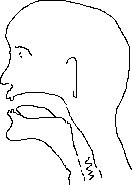

Pronunciation may be one of the most difficult aspects of language to teach. At worst, students have problems requiring expertise in speech pathology -- a lateral lisp, stuttering, or some other problem that affects their first language as well as their second. At best, students are quite understandable but would like to sound as close as possible to a native speaker. Most of the people I work with fall in between the two, and that's the group the tips for this month and next month will target.
For my class, I'm using information found on the Web, put together by my colleague Helen Polensek, and from my own training and experience (training which does not include speech pathology, by the way). My pronunciation class meets for 5 weeks, 3 hours per week. It is designed to prepare students to study on their own. While students do improve in the 5 weeks, it's rarely enough to get them to their target zone, so they need study skills for pronunciation.
My syllabus is at https://www.deborahhealey.com/138/138syllabus.html. It starts with work on "state of mind" -- trying to relieve learner anxiety about pronunciation. Because the way you speak is part of who you think you are, it's important that learners be mentally flexible about their self-image. I ask them to think about an American they like, usually someone in the entertainment industry, who is the same gender as they are (thus not Leo deCaprio for the young women!). They need to try to find a picture of that person to help strengthen the image of that person in their minds. This image is their role model in pronunciation, the person they will "be" when speaking English.
Fan clubs abound for people in the entertainment industry. A good starting point for finding pictures of current movie stars is at Yahoo's Actors and Actresses index, https://www.yahoo.com/Entertainment/Actors_and_Actresses/
If students aren't sure of the spelling, they can click on the letter of the person's last name and browse through the list. If they're sure, they can type in the name and choose to search within the category.They can use the same procedure to search for musicians at Yahoo's Music Artists index, https://www.yahoo.com/Entertainment/Music/Artists/
We then talk about what they perceive as their problems in speaking. They must truly believe they have a problem if they are to change pronunciation. They do an audiotape for a diagnostic (videotape is better, but more difficult logistically at the beginning of term). I evaluate the diagnostic, then give them a list of suggestions, including books with tapes, videos, and software (more on the software next month).
Vocabulary is kept to a minimum, but some specialized vocabulary is helpful:
Vowel/consonant: a e i o u / everything else. It's good to be sure students recognize the difference between letters and sounds. The best way is to write a number of words on the board that have the same vowel letter, but very different vowel sounds, such as the o sound in robot, book, woman, women.
Vocal cords: Show the cutaway diagram, then have students push on the indentation in the throat and say some vowel and voiced consonant sounds (below) to feel theie vocal cords vibrate.
Roof of the mouth: Show the cutaway diagram, then have students touch the roof of their mouth with their tongue. You can also ask students if that place has a similar name in their own language.
Voiced/voiceless consonant sounds: Have students do the vocal cords exercise, then say the voiced/voiceless pairs: b/p, d/t, g/k, v/f, z/s, j/ch, zh/sh
You can also explain these as sounds you can whisper, and ones you can't--have them try the pairs to see. They can also go through the alphabet and decide what category the other consonant sounds -- h, l, m, n, r, w, y -- fall into.
Tense/lax vowels: Thinking about tense and lax helps people feel the difference in the vowel pairs in heed and hid, hate and hat, boot and book.
Long/short vowels: This is a useful distinction when talking about syllable length -- long vowels tend to take longer to say, especially in stressed syllables.
![]() Schwa: It's the most common vowel sound in English, so it's
the best way to describe the sound of most vowels in unstressed
syllables.
Schwa: It's the most common vowel sound in English, so it's
the best way to describe the sound of most vowels in unstressed
syllables.
Dipthong: This is a combination of vowel sounds, as in boil and down. It may be helpful for students to think about the long vowel sounds as dipthongs that use y and w as vowels -- ay, eey, iey, ow, yuw, uw

And the ordinary vocabulary of face parts: mouth, lips, tongue, teeth, jaw
We use a cutaway diagram that looks something like this to help students visualize.
An important part of using the diagram is having students feel the parts of the mouth to cement their understanding. They can use their fingers to touch some of the parts, such as the lips, teeth, tongue, and jaw, and feel the place on the throat closest to the vocal cords. They then use their tongue to touch the hard palate and soft palate (explained as the hard part just behind the teeth and the softer part at the roof of the mouth).
Having another persona is very good in the pronunciation class, since students need to feel free to do very strange things with their faces and voices in the company of the others in the class. We work a lot on holding the mouth wide open, wiggling the tongue, moving the jaw around -- not the most picturesque behavior, but useful for breaking habits established in their first language.
Another way to build flexibility is to ask students to read a passage as if they were children, the opposite gender (especially good in mixed-gender pairs), and very old people. Another method is to bring in movie clips of people with distinctive voices -- Madonna and John Wayne are good examples. Students can try to mimic the voices of these artists. Taking it easy and having fun help a lot in breaking down barriers to change.
Next month's tip will describe the strengths and weaknesses of some of the software we've used.You can see what might fit your program best from a wide array of what's out there.
Tip to remember: the part of the body most important to pronunciation is the mind.
If you have questions, comments, or for more information,
contact Deborah Healey, dhealey AT uoregon DOT edu
https://www.deborahhealey.com/techtips/may1998.html
Last
updated 8 October, 2009